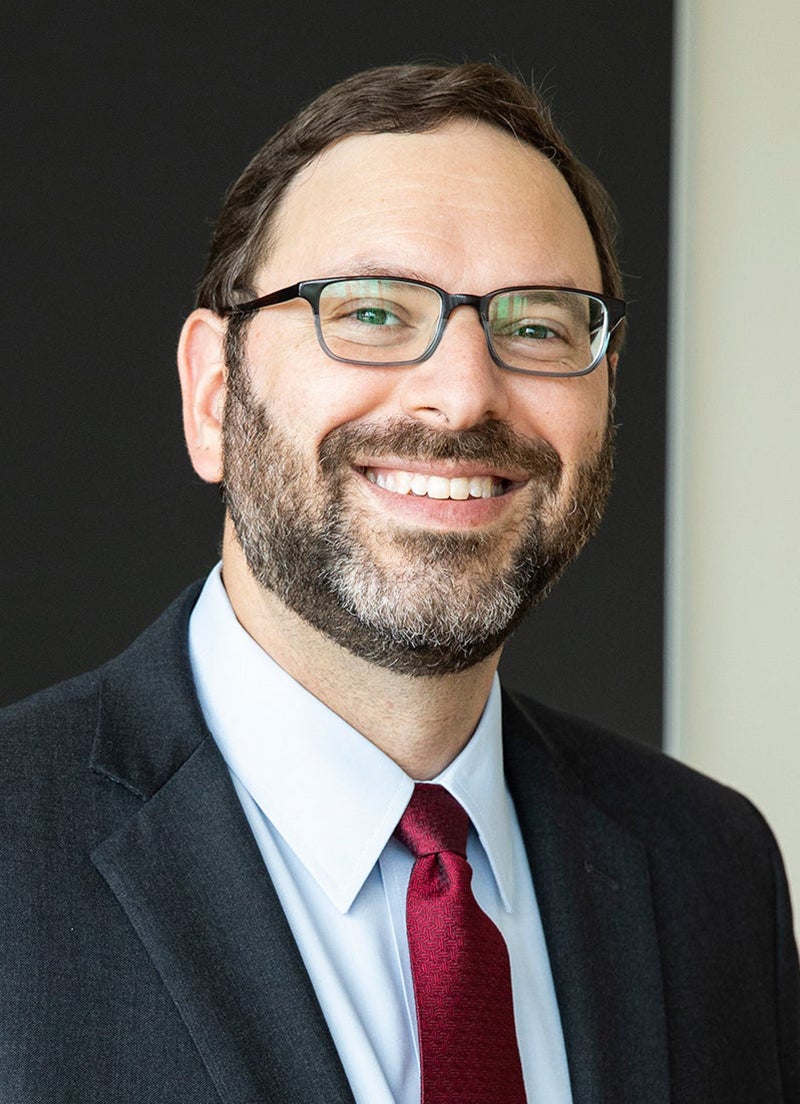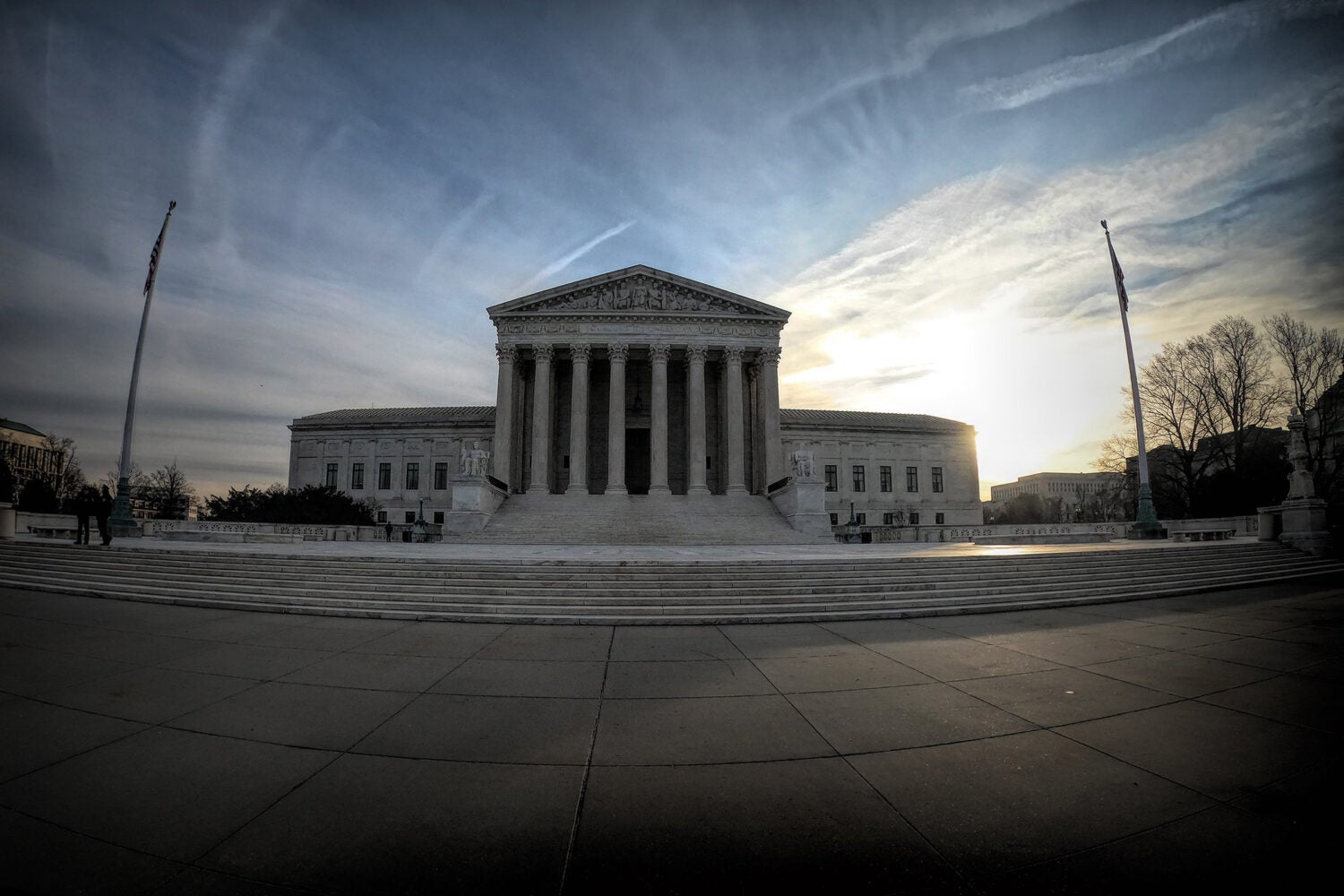Are ghost gun kits “firearms” for the purpose of regulation under existing statutes? Can foreign terrorism cases be heard in U.S. courts? Does a Tennessee ban on certain kinds of medical care for transgender minors violate the Equal Protection Clause?
These are the questions at the heart of some of the most noteworthy cases that the U.S. Supreme Court will consider in the new term that begins on October 7 — at least according to experts at an event at Harvard Law School last week. The talk, sponsored by the Harvard Federalist Society, featured Stephen Sachs, the Antonin Scalia Professor of Law at Harvard, and Jeff Redfern ’12 and Justin Pearson of the Institute for Justice, a nonprofit law firm.
As part of the event, Sachs and Redfern discussed the Supreme Court cases they’re eagerly following — including two the Court is set to hear in the coming months, and a pair the justices may consider taking on in the future.
Garland v. VanDerStok
Redfern began by highlighting Garland v. VanDerStok, which centers on so-called “ghost guns” — or ready-made parts kits that can be assembled into weapons. The Court will hear oral arguments in the case on October 8.
At issue is the Gun Control Act of 1968, a key piece of federal gun regulation, which “defines as a firearm something that expels a projectile by means of an explosion, or something that can be readily converted to do so, like a starter pistol at a track meet — those are technically firearms. Or it’s the frame or receiver of such a weapon,” Redfern explained.

In 2022, the Bureau of Alcohol, Tobacco, Firearms and Explosives issued a rule indicating that it viewed the frames of ghost guns — which are often “carefully made to be inconvenient in some way,” Redfern noted — to fall under the law. Kit manufacturers and gun owners promptly sued.
The big question, Redfern said, is whether the collection of parts can be considered a “firearm” under the act — and therefore subject to regulation under the statute.
Interestingly, the case has been up to the Supreme Court already, twice appearing on its emergency (or “shadow”) docket, before finally being heard in full this term, Redfern said.
And importantly, he added, VanDerStok is not a Second Amendment case. “It’s not about rights at all; it’s about what the statutory text means, and what the ATF is allowed to do.”
The case is one of “hard statutory interpretation,” Redfern continued. “And it’s in our post-Chevron world where we’re not giving any deference to agency interpretations,” he added, referring to the longstanding — and now defunct — principle of Chevron deference, which held that courts should generally yield to the expertise of administrative agencies like the ATF when writing implementing regulations for a law that is unclear.
“These are the kind of things that historically, if they were articulating a rule that seemed somewhat reasonable, they probably would have gotten deference,” he said. “And now courts have to say, what is something that can be ‘readily converted’?”
When the Fifth Circuit Court of Appeals heard the case, it held “that [the ATF’s] regs are not a valid reading of the act, that a collection of parts is not a weapon. And they looked, to some extent, at the history of what [Congress was] thinking about when they enacted this, which was a completed gun that had something done to disable it. This is a step removed from that.”
Redfern said that the appeals court also found that the parts did not qualify as a “frame,” either, because steps had to be completed before it could effectively function as one.
“The government is doing really good textual argument in this case, and I think that’s something that’s an important change in the last five or so years.”
Jeff Redfern
In the briefs submitted to the Supreme Court, Redfern said he noticed an intriguing development: “The government is doing really good textual argument in this case, and I think that’s something that’s an important change in the last five or so years.”
As an example, a brief by Solicitor General Elizabeth Prelogar ’08 argued that letting gun kits escape regulation under the act would be akin to allowing IKEA to avoid a tax on tables and chairs, Redfern said, simply because they sell those items disassembled.
He urged students interested in litigation to pay attention to VanDerStok. “It’s worth taking a look at the briefs and listening to the argument, because the quality of the advocacy, particularly out of the office of the Solicitor General, is just fantastic now on textual issues, and it really teaches you how to argue these cases.”
But he also identified what he believes is an area of weakness on the government’s part, specifically at the lower court levels, where it failed to identify its view on when, exactly, “in this continuum from a hunk of metal to a gun that just needs to have pieces put together, [it becomes] ‘readily convertible’” and therefore subject to regulation under the law in question, Redfern said.
“I think the lurking issue here is that there are line drawing problems,” Redfern concluded. “And courts hate line drawing problems. That’s one of the things that Chevron got them out of.”
U.S. v. Skrmetti
The Supreme Court may also decide the fate of contentious state laws banning medical or surgical treatments associated with gender transition for minors in United States v. Skrmetti, which Sachs identified as another important case to watch this term.
After Tennessee passed its version of such a law, a group of transgender minors and their guardians sued, with the U.S. eventually intervening in the case. At the district court, the judge granted the plaintiffs a preliminary injunction pausing the law’s implementation while litigation proceeded, but the Sixth Circuit Court of Appeals reversed that decision, causing a split with other circuits over the issue.
Ultimately, the plaintiffs and the federal government sought Supreme Court review, which it granted — but only as to the federal government’s arguments. The plaintiffs’ cases, meanwhile, are “sitting on the docket waiting for this case to be resolved,” Sachs said.
In practice, he added, that means that certain of the plaintiffs’ arguments, like those involving substantive due process around the right to try certain kinds of medicines, or parental rights, are “off the table” in the present case.
Instead, “what the Court granted on was the question of equal protection,” he continued.

Before anything else, the Court will have to determine the appropriate standard on which to evaluate the Tennessee law, Sachs said. When determining whether a law may be unconstitutional, a court applies one of three escalating levels of judicial review, the first of which is “rational basis,” which is the lowest bar for the government to meet, and the test the Sixth Circuit applied in this case. The test asks whether the “law is rationally related to a legitimate state interest,” Sachs said.
“Although you can sometimes prevail against the state on this ground, there’s typically a really high bar for the challenger,” he explained. “It’s hard to show that a regulation of medical procedure is not rationally related to some legitimate state interest, especially because the inquiry typically asks, could the legislature have thought that this was so related?”
Under this test, it would likely be enough to show that the legislature chose to believe some medical authorities and not others about the benefits and risks of the treatments, he added.
But the plaintiffs — and the federal government — in Skrmetti are asking for a heightened level of scrutiny, Sachs clarified. “They say that the test should be whether the law is substantially related to achieving an important government objective.”
This test would mean bringing two additional factors into the inquiry: “On the one hand, it means that the Court would have to look at the medical evidence somewhat more. Because it couldn’t just trust the legislature, it would have to say, ‘Do we agree that there is enough here that it is substantially related?’ And that requires it to look at the actual facts one way or the other.”
Secondly, the Court would have to consider what, exactly, is an “important governmental objective,” Sachs said.
But current doctrine requires that, in order to qualify for this higher level of review, the law must meet other requirements, such as discriminating based on membership in a “suspect class.”
“One possibility would be that it discriminates on the basis of sex,” he said. “Another is that it discriminates on the basis of membership in what’s called a quasi-class, and there’s an argument whether transgender status qualifies as such a class. And this, too, is the subject of multiple circuit splits.”
Regarding the first possibility, Sachs indicated that the Court’s analysis in 2020’s Bostock v. Clayton County is illustrative but not dispositive. “Bostock … raised the question whether employment discrimination on the basis of sexual orientation or gender expression was ‘on the basis of sex’ within the meaning of Title VII of the Civil Rights Act. The Court in Bostock said that it was. [But] there’s some debate on whether Title VII and the Equal Protection Clause use the same categories, whether the Equal Protection doctrine is the same as Title VII doctrine, etc.”
The plaintiffs are less likely to prevail on the second basis, Sachs said. “The Supreme Court has been extremely reluctant to recognize new quasi suspect classes.”
But, even if the plaintiffs succeed in convincing the Court to apply a more stringent standard of review to the ban, the case doesn’t end there, Sachs said. “Assuming that heightened scrutiny does get applied, what happens? … The parties on each side argue that they would win.”
If that happens, the Supreme Court could either send the case back down to the lower court to determine whether the Tennessee law meets the higher bar — or it could start the inquiry on its own.
Future cases to watch
Finally, Redfern and Sachs shared two pending petitions for certiorari — or requests for appeal to the Supreme Court — that they are following, to see if the Court grants a hearing.
Redfern selected No on E v. Chiu, which asks whether a San Francisco law that requires the sponsors of election ads to list their top three donors violates the First Amendment. The law is overly burdensome, he said.
“It means, in practice, that smaller print ads are actually impossible if you’re complying with the typeface requirements, and even medium sized print ads were half disclosure. [For] audio ads, they timed people doing these disclosures, and it was over 30 seconds, so you can’t do a short audio ad. And if you do a long ad, no one is going to listen by the time you got to the actual ad.”
Redfern said that he believed the Court would likely strike down the law if it chose to hear the case. “I think the tricky thing here, though,” he continued, “is that there are precedents upholding compelled disclosure in the political space. So, then, that brings us once again to line drawing.”
For Sachs, the case to watch is Fuld v. Palestine Liberation Organization, which raises an unanswered civil procedure question — and a broader debate about the global reach of U.S. courts.
In 1992, Congress passed the Antiterrorism Act, which provided an extraterritorial right of action for U.S. victims of terror attacks abroad, said Sachs. “But it doesn’t require that the attacker know or intend to be targeting Americans. It has very broad provisions on personal jurisdiction,” he said referring to the question of when courts have authority to hear cases involving particular parties.
And since the case was filed in 2004, Congress has passed several additional laws intended to clarify or extend jurisdiction over foreign defendants of this kind, Sachs added.
But for state courts, there are limits to personal jurisdiction — or the court’s authority to make judgments affecting a particular person or entity — applied under the Fourteenth Amendment’s Due Process Clause, he said. Does the Fifth Amendment’s due process clause impose similar restraints on federal courts?
“Most circuits have sort of assumed that it does, on the theory that the United States is like a big state,” he said. “But the Supreme Court has many times said, ‘We’re not going to touch that one,’ and so it’s never been resolved.”
Unlike many other cases that make it to the nation’s highest court, the question in Fuld would not be “is this illegal” or “does Congress have the power to prohibit this,” Sachs said. “It’s, ‘Does Congress have the power to bring these cases into the United States courts?’”
Want to stay up to date with Harvard Law Today? Sign up for our weekly newsletter.
